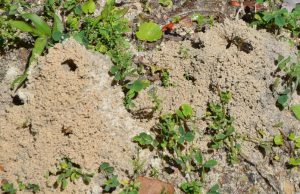
By Les Harrison
Wakulla County Extension Director
There are certain sounds which attract the immediate attention of people and set off instinctive reactions. Car alarms and sirens are two good examples.
At the first sound of a car alarm, most of those present instantly look around to see what occurred. It may be simple and harmless as the owner accidently hitting the panic button on the key fob, or something much more serious.
The long high pitched scream of a siren likewise engenders an innate set of reactions. If in traffic, the first thought is where to quickly pull off the roadway so the first responders may arrive at the quickest possible moment to those is desperate need of aid.
Another noise which prompts a sudden response is the buzzing of insects in close proximity. Inevitably many who experience this auditory trauma anticipate one or more stings to quickly follow the acoustic alarm.
April provides the residents of Wakulla County many potential opportunities to test their reflexes when it comes to buzzing insects. Fortunately most of the airborne offenders are harmless to humans, for the most part, and many even beneficial to the native environment.
One noisy native insect is the plasterer bee, sometimes known as the polyester bee. Colletes inaequalis, as it is formally known, has the curious practice of smoothing the walls of their nest cells with secretions applied with their mouthparts.
When dry the lining has the texture of a cellophane sleeve. This habit occurs with all approximately 2000 members of this bee family.
Unlike the more commonly known bumblebees and carpenter bees, the plasterer bee is a ground nester. Of the about 20,000 species of bees worldwide, around 70 percent nest underground.
In North America many of these ground nesting bees become active in early spring. Nests of these bees are easy to identify from the exterior because of the conical heaps of dirt with a large hole in the middle which serves as the entrance to the burrows.
Unlike the European honeybee, the plasterer bee is classified solitary insect, meaning that every individual female builds her individual nest and raises her own brood. It is, however, a gregarious nester with many females, sometimes in the thousands, building their nests next to each other.
During the spring with heavy interaction between males and females, there will be much noisy flying and darting about. It is easy to confuse this with a prelude to an attack.
Solitary bees, as a group, are much more docile than social insects such as wasp and European honeybees. As a general rule they will not attack unless injured or harmed.
The females have stingers as is typical with other bees. Males do not have stingers and are completely harmless.
The plasterer bee has a strong preference for sandy soils which are common in Wakulla County. This geologic feature encourages these bees to return to the same nesting sites every year.
Generally these bees only fly for a few weeks in the spring, and then their holes disappear and they disperse.
Their hyperactive spring appearance and loud activity may be a bit unnerving, but they are just a temporary noisy neighbor. Ignore them and they will go away.
To learn more about native bees in Wakulla County contact the UF/IFAS Wakulla County Extension Office at 850-926-3931 or https://blogs.ifas.ufl.edu/wakullaco/.
 0
0
